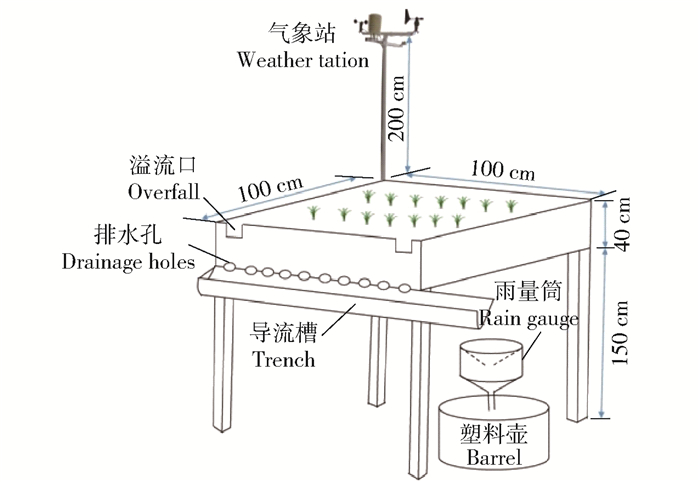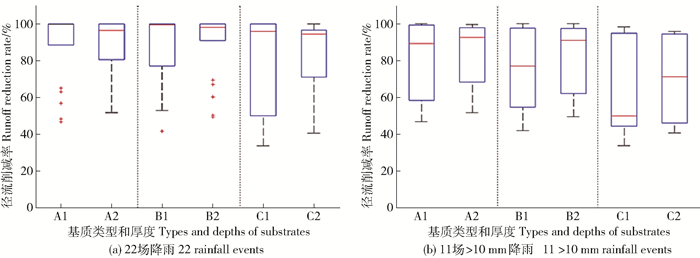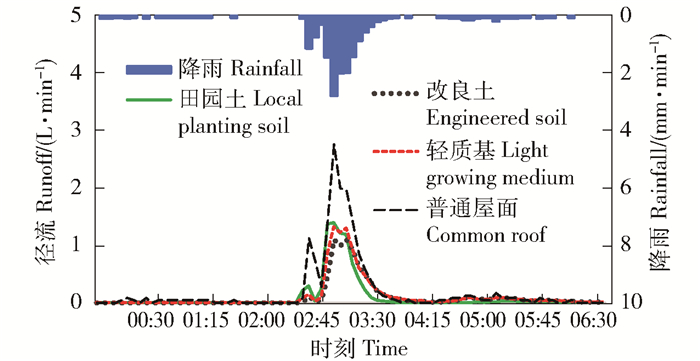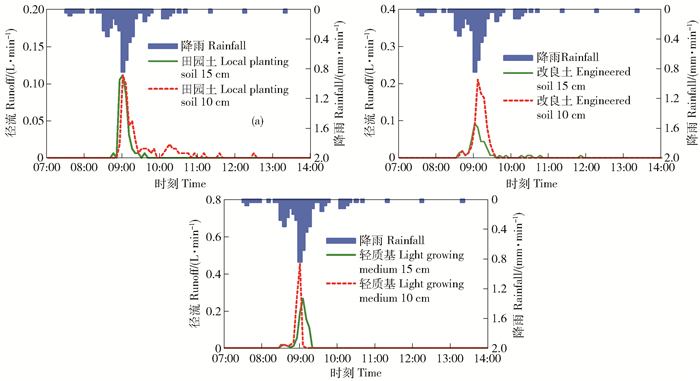-
项目名称
- 国家水体污染控制与治理科技重大专项"北运河上游水环境治理与水生态修复综合示范"(2017ZX07102-001);国家自然科学基金"绿色屋顶雨水滞留能力变化过程研究"(51609004)
-
第一作者简介
- 葛德(1993-), 男, 硕士研究生。主要研究方向:城市雨水控制与利用。E-mail:gede2222@126.com
-
通信作者简介
- 张守红(1985-), 男, 副教授。主要研究方向:城市雨水控制与利用, 小流域综合治理。E-mail:zhangs@bjfu.edu.cn
-
文章历史
-
收稿日期:2018-05-17
修回日期:2018-12-16
在城镇化进程中,公路、街道、建筑等基本不透水城市景观取代原有的森林、草地、农田等透水地表,阻止雨水下渗和土壤水分蒸发,破坏流域自然水循环,引发城市热岛和内涝积水等生态环境问题[1-2]。为解决这些问题,我国借鉴低影响开发、可持续城市排水系统和水敏感城市设计等现代城市雨洪管理理念,结合我国雨水控制与利用的传统智慧,提出并推广海绵城市建设战略[3]。绿色屋顶,作为海绵城市建设的重要措施之一,具有滞留雨水、减少径流、削减和延缓洪峰等径流调控功能[4-5]。相比其他低影响措施,绿色屋顶的优势在于可利用闲置屋顶,无需额外用地,在土地空间有限但环境问题突出的城镇核心区域具有较大的应用前景[6]。
绿色屋顶从上到下可分为植被层、基质层、过滤层、排水层和阻根防水层等[4, 6]。根据基质层的厚度,绿色屋顶可分为复式(集约型)和简式(粗放型)2类[7-11]。复式绿色屋顶的基质层较厚,可种植草本、灌木和小乔木等多种植物,但对建筑的承重要求以及建造、养护成本相对较高。简式绿色屋顶基质层较薄,适宜种植浅根草本植物,因建造和养护成本相对较低[12],且具有良好的径流调控[5]、节约能源[13]和增加生物多样性[14]等功能,应用较广泛[15]。
绿色屋顶的径流调控功能主要通过其植被层和基质层对雨水的截留和滞留过程实现[16]。简式绿色屋顶的植物截留量相对较小,基质层雨水滞留能力是决定其径流调控功能的主要因素[17]。研究表明,基质层雨水滞留能力主要受生长基质持水特性和厚度影响[4-5]。基质层厚度是绿色屋顶径流调控能力最重要的影响因素之一[5];基质粒径不同,其蓄水能力也具有显著差异[18-20],小粒径颗粒物[20]和有机物[21]含量越高,会与大颗粒之间产生更多的储水空间,导致滞留雨水能力更强。国内外学者对绿色屋顶雨水滞留能力进行了大量的实验[18, 22-25]和模拟[16, 26-31]研究。受到气候条件、基质类型和植被类型等因素影响,不同绿色屋顶的雨水滞留能力存在差异。Razzaghmanesh等[32]在阿德莱德通过实验研究发现,10 cm基质厚度的绿色屋顶平均雨水滞留率为74%;Wang等[33]的研究得到天津市7个10~15 cm基质厚度的绿色屋顶的平均滞留率为43%;Stovin等[34]监测了谢菲尔德22场大于5 mm的降雨,发现8 cm基质厚度的绿色屋顶能够滞留30%雨水。当前研究主要集中于绿色屋顶的雨水滞留和径流削减能力,而关于绿色屋顶的洪峰削减效益、产流和洪峰时间延迟效益的研究相对较少。
此外针对我国不同气候区,尤其是北方地区城市绿色屋顶径流调控的实验监测研究相对匮乏[5]。笔者基于在北京市对3种生长基质(轻质基、改良土和田园土)和2个基质层厚度(10 cm和15 cm)共6个佛甲草(Sedum lineare)绿色屋顶降雨径流过程的长期连续监测实验,以径流削减率、洪峰削减率、产流延迟时间和峰现延迟时间等为指标,定量分析生长基质类型及厚度对绿色屋顶径流调控效益的影响。研究结果可望为绿色屋顶的水文设计及径流调控效益评估提供科学基础,为我国北方海绵城市建设提供科技支撑。
1 材料与方法 1.1 实验设计实验绿色屋顶建在北京市海淀区北京林业大学林业楼顶,位于北京北四环到北五环之间,具有典型的北方城市小气候特征。气候类型为北温带半湿润大陆性季风气候,年降水量644 mm,夏季高温多雨,冬季寒冷干燥,春、秋短促。降水季节分配很不均匀,全年降水的80%集中在夏季(6、7和8月)[35]。根据北京城区松林闸雨量站的降雨数据,北京市3年一遇、5年一遇、10年一遇的24 h降雨量分别为108、141和209 mm。
本实验共设计6个1 m×1 m的试验绿色屋顶(表 1)。绿色屋顶从上向下依次为植被层、生长基质层、过滤层、排水层和防水保护层。佛甲草因其具有极强的耐低温和抗旱能力且绿色期较长、根系浅,是常用的屋顶绿化植物。基质层包含田园土、改良土和轻质生长基质(简称“轻质基”)3种类型。田园土从北京林业大学实验苗圃中取得。改良土由轻砂壤土、腐殖土、珍珠岩、蛭石按2.5:5:2:0.5的比例混合而成。轻质基质由浮石、草炭土、沸石、碎木屑按4:3:2:1的比例混合而成。过滤层为300~400 g/cm3聚酯无纺布,排水层由厚度为10 cm直径>30 mm的陶粒组成,防水层为TPO防水卷材。
| 表 1 佛甲草绿色屋顶设计参数表 Tab. 1 Design parameters of the green roofs with Sedum lineare |
实验装置如图 1所示,采用架设于绿色屋顶上方2 m,雨量分辨率为0.2 mm的HOBO U30自动小气象站监测降雨过程。采用雨量分辨率为1 mm的自记式雨量计监测径流过程。二者监测间隔皆为5 min。为保证数据可靠性,在每个监测径流的雨量计下放置1个250 L的塑料壶,承接绿色屋顶径流。每场降雨结束后根据塑料桶内收集径流总量检验和校核雨量计的测量结果。本文分析主要基于2017年雨季共22场降雨径流数据。

|
图 1 实验装置示意图 Fig. 1 Structural diagram of the experiment setup |
经测定,林业楼顶防水油毛毡表面对雨水的滞蓄能力为1.0 mm左右,即当降雨量大于1 mm时,超出部分转化为径流。场降雨量为p (p>1 mm)时,普通屋顶产生的径流量为(p-1),绿色屋顶的产流量为R,皆以mm计。相对于普通屋顶,绿色屋顶的场降雨径流量削减率(简称“径流削减率”)(Dr)可由下式计算:
| $ {D_{\rm{r}}} = \frac{{(p - 1) - R}}{{(p - 1)}} \times 100\% 。$ | (1) |
规格为1 m×1 m的绿色屋顶和普通屋顶的汇流时间小于雨量和径流监测时间间隔(5 min),因此,笔者以绿色屋顶开始产流时间与降雨开始时间的差值为产流延迟时间,以绿色屋顶径流峰值时间与降雨强度峰值时间的差值为峰现延迟时间,分别衡量绿色屋顶对产流和峰现时间的延迟效益。绿色屋顶的洪峰削减率(Dpr)可由下式计算:
| $ {D_{{\rm{pr}}}} = \frac{{{D_{\rm{P}}} - {D_{{\rm{Pg}}}}}}{{{D_{\rm{p}}}}} \times 100\% 。$ | (2) |
式中:Dp为普通屋顶洪峰流量,L/min;Dp为绿色屋顶洪峰流量,L/min。
2 结果与分析 2.1 3种生长基质物理性质对比分析基于张建军等[36]测定方法测得田园土、改良土和轻质基的密度、孔隙度、田间持水量及饱和导水率等物理特性如表 2所示。田园土的密度最大(1.13 g/cm3),是轻质基密度约2倍。改良土的密度居中,为0.63 g/cm3。改良土的孔隙度和田间持水量最大,分别为61.26%和41.41%。田园土的孔隙度最小,为48.35%。轻质基的田间持水量最小,为33.70%。轻质基的饱和导水率为266 mm/h,是田园土饱和导水率的约3.5倍。Zhang等[28]通过文献总结绿色屋顶生长基质的孔隙度变化范围为41%~46%,田间持水量的变化范围为11%~50%,饱和导水率的变化范围为69.9~288.0 mm/h。本研究测定的以上物理量均与文献资料的数据变化范围相差较小。田园土虽容易获取,但其密度过高,湿密度可达到1.62 g/cm3,10~15 cm厚度的田园土加上排水层和植被层产生的荷载易超过普通屋顶的设计荷载200 kg/m2[37],且导水性较差,不宜用于屋顶绿化。
| 表 2 生长基质物理性质 Tab. 2 Physical properties of the substrates |
不同基质类型和厚度绿色屋顶径流削减率的统计分布如图 2所示。监测期内22场降雨中,< 10 mm的有11场。降雨量 < 10 mm时,各绿色屋顶基本无径流产生,径流削减率接近100%。因 < 10 mm降雨场次的频率较高(50%),不同基质类型绿色屋顶径流削减率的中位数和上四分位值都在95%以上,相差不大(图 2(a))。图 2(b)显示了降雨量>10 mm的11场降雨各绿色屋顶径流削减率的统计分布。由图中可见,当基质厚度相同时,轻质基绿色屋顶径流削减率的中位数、下四分位和最小值比其他2种基质类型的绿色屋顶均较低,表明轻质基绿色屋顶在中到暴雨条件下的径流削减效益较田园土和改良土绿色屋顶低。

|
图 2 实验绿色屋顶场降雨径流削减率统计分布 Fig. 2 Statistical distributions of per-event runoff reduction rates by experimental green roofs |
各绿色屋顶在监测期内径流调控指标的平均值及变化范围如表 3。田园土绿色屋顶的径流削减率高于改良土,但并未通过0.05显著性水平Wilcoxon检验。轻质基绿色屋顶的径流削减率显著低于其他2种基质(P < 0.05)。改良土绿色屋顶的洪峰削减率最高,但与田园土绿色屋顶的差异不明显。各绿色屋顶都有良好的产流延迟效益,田园土绿色屋顶的产流延迟时间显著高于轻质生长基绿色屋顶(P < 0.05)。各绿色屋顶的平均峰现延迟时间在34.3到38.6 min之间,不同基质类型的绿色屋顶之间洪峰延迟效益无显著差异。轻质基与改良土和田园土相比,透水性较强,持水性较差,是轻质基绿色屋顶径流和洪峰削减率较低的重要原因。
| 表 3 实验绿色屋顶径流调控效益 Tab. 3 Runoff hydrological performances of experimental green roofs |
图 3显示了各绿色屋顶对2017年7月15日暴雨(5年一遇)的径流响应过程。“7·15”暴雨总降雨量为81.4 mm,最大2 h平均雨强为35.2 mm/h。厚度为15 cm的田园土、改良土、轻质基绿色屋顶分别产流41.7 L、46.8 L和51.5 L,径流削减率分别为48.2%、41.7%和35.9%;洪峰流量分别为1.48 L/min、1.31 L/min和1.41 L/min,洪峰削减效益分别为45.4%、52.5%和48.9%。3种基质类型屋顶洪峰削减效益的大小与它们的孔隙度和田间持水量的大小排序一致,说明生长基质孔隙特征是决定其径流调控的主要因素之一。田园土和改良土绿色屋顶在降雨开始160 min后产流,轻质基则在降雨开始55 min后产流,都具有较好的产流延迟效益。3种基质类型绿色屋顶洪峰与最大降雨强度几乎同时出现,并未表现出明显的峰现延迟效益。

|
图 3 不同基质类型15 cm基质层厚度实验绿色屋顶对“7·15”暴雨的径流响应过程 Fig. 3 Runoff reponses of experimental green roofs with 15 cm substrate depths in different substrate types during the "7·15" storm event |
如图 2(a)所示,相同基质类型,不同基质厚度的绿色屋顶对监测期内22场降雨径流削减率统计分布的差异并不明显(图 2(a))。但当仅统计降雨量大于10 mm的11场降雨时(图 2(b)),15 cm基质厚度绿色屋顶径流削减率的中位数、下四分位和最小值均高于10 cm厚度同种基质的绿色屋顶。
当降雨量较大时(>15 mm),15 cm基质层厚度的绿色屋顶径流削减率显著高于10 cm厚度的绿色屋顶(P < 0.05)。如表 3所示,基质厚度为15 cm的绿色屋顶洪峰削减率高于10 cm厚度同种基质的绿色屋顶。
图 4反映了各绿色屋顶对2017年8月12日降雨的响应过程。10 cm厚度田园土、改良土和轻质基绿色屋顶的径流量分别为2.67 L、5.77 L、12.59 L,都高于15 cm厚度同基质类型绿色屋顶的径流量(分别为1.86 L、2.26 L和7.29 L)。10 cm厚度的改良土和轻质基绿色屋顶的洪峰流量都明显高于15 cm厚度绿色屋顶的洪峰流量。以改良土为例,10 cm和15 cm厚度绿色屋顶的洪峰流量分别为0.21 L/min和0.09 L/min。基质层厚度对绿色屋顶产流和峰现时间延迟效益的影响不大。

|
图 4 不同基质层厚度实验绿色屋顶对“8·12”降雨的径流响应过程 Fig. 4 Runoff responses of experimental green roofs with different substrate depths during the "8·12" rain event |
绿色屋顶主要通过植被层、生长基质层和排水层滞留雨水和调蓄径流,实现其径流和洪峰削减、产流和峰现时间延迟等径流调控效益[38]。研究表明[16, 26-27]:绿色屋顶一般为非饱和产流,即当基质层的含水量超过其田间持水量时,超出的雨水将以渗流的形式从绿色屋顶底部排走。当降雨量未超过绿色屋顶的滞留能力时,即生长基质层未达到田间持水量时,雨水会被绿色屋顶全部吸收,此时几乎没有径流产生[28]。因此,本研究中当降雨<10 mm时,不同基质类型和厚度的绿色屋顶基本都不产流,因而径流调控效益差异不明显,而当降雨量>10 mm, 不同基质厚度的绿色屋顶的径流调控效益的差异得以显现(图 2(a)、图 2(b))。
绿色屋顶对产流和峰现时间的延迟效益主要与植被层和基质层滞蓄雨水过程有关。雨水滞蓄过程主要受生长基质的孔隙特征控制[38],同时也受降雨强度和前期基质含水量的影响[39]。当基质层含水量达到其田间持水量时,绿色屋顶开始产流[27-28]。另外,由于绿色屋顶基质结构一般较为松散,如本研究中的轻质基,内部有大孔隙存在,因此在未超过绿色屋顶滞蓄能力(田间持水量)的情况下,也会有部分雨水会沿着这些大孔隙,以优先流的方式产流[38]。洪峰出现时间延迟主要受绿色屋基质层下渗性能[21]和排水系统汇流时间等因素影响。Chen[40]指出,对于少量的降雨或者短时间的场降雨而言,达到峰值所需时间取决于绿色屋顶的滞留能力。但当发生高强度降雨时,绿色屋顶对雨水的滞留能力和对径流的延缓能力相对有限,因而各种基质类型的绿色屋顶对高强度降雨响应相似。本实验的降雨和径流监测时间间隔为5 min,因而绿色屋顶的实际产流和峰值延迟作用小于5 min,监测结果都显示为延迟0 min。而实验中3种生长基质的绿色屋顶透水性能较好(≥77 mm/h),实验屋顶面积为1 m×1 m,最长汇流路径仅有
本研究基于对位于北京市区的3种基质类型(轻质基、改良土和田园土)2个基质厚度(10 cm和15 cm)共6个绿色屋顶在2017年22场降雨和径流过程的监测数据,定量分析生长基质类型及厚度对绿色屋顶径流调控效益影响,得出主要结论如下。
1) 改良土和田园土绿色屋顶22场降雨的平均径流削减率、洪峰削减率和产流延迟时间均高于相同厚度的轻质生长基绿色屋顶。轻质基、改良土和田园土绿色屋顶的平均径流削减率分别为82.2%、88.4%和89.4%,平均洪峰削减率分别为55.9%、65.6%和63.9%,平均产流延迟时间分别为48.8、106.2和163.9 min。因密度偏高、导水性较差,田园土不宜用于屋顶绿化。
2) 基质层厚度为15 cm的绿色屋顶的径流调控效益高于10 cm厚度的同种基质绿色屋顶。15 cm厚度轻质基绿色屋顶的平均径流削减率、洪峰削减率、产流和峰现延迟时间分别为83.2%、61.2%、51.7 min和38.6 min,而10 cm厚度对应的径流调控指标分别为81.3%、50.6%、45.9 min和34.3 min。
3) 基质类型和厚度对绿色屋顶径流调控效益的影响随降雨条件而改变。小雨(< 10 mm)条件下因各绿色屋顶几乎都不产流而无明显差异,中到暴雨(>10 mm)条件下不同基质类型和厚度绿色屋顶的径流削减率差异显著。
| [1] |
张建云, 宋晓猛, 王国庆, 等. 变化环境下城市水文学的发展与挑战:Ⅰ.城市水文效应[J]. 水科学进展, 2014, 25(4): 594. ZHANG Jianyun, SONG Xiaomeng, WANG Guoqing, et al. Development and challenges of urban hydrology in a changing environment:I:Hydrological response to urbanization[J]. Advances in Water Science, 2014, 25(4): 594. |
| [2] |
王书敏, 何强, 张峻华, 等. 绿色屋顶径流氮磷浓度分布及赋存形态[J]. 生态学报, 2012, 32(12): 3691. WANG Shumin, HE Qiang, ZHANG Junhua, et al. The concentrations distribution and composition of nitrogen and phosphor in stormwater runoff from green roofs[J]. Acta Ecologica Sinica, 2012, 32(12): 3691. |
| [3] |
李兰, 李锋. "海绵城市"建设的关键科学问题与思考[J]. 生态学报, 2018, 38(7): 2599. LI Lan, LI Feng. The key scientific issues and thinking on the construction of "Sponge City"[J]. Acta Ecologica Sinica, 2018, 38(7): 2599. |
| [4] |
BERNDTSSON J C. Green roof performance towards management of runoff water quantity and quality:A review[J]. Ecological Engineering, 2010, 36(4): 351. DOI:10.1016/j.ecoleng.2009.12.014 |
| [5] |
陈小平, 黄佩, 周志翔, 等. 绿色屋顶径流调控研究进展[J]. 应用生态学报, 2015, 26(8): 2581. CHEN Xiaoping, HUANG Pei, ZHOU Zhixiang, et al. A review of green roof performance towards management of roof runoff[J]. Chinese Journal of Applied Ecology, 2015, 26(8): 2581. |
| [6] |
葛德, 张守红. 不同降雨条件下植被对绿色屋顶径流调控效益影响[J]. 环境科学, 2018, 39(11): 5015. GE De, ZHANG Shouhong. Impacts of vegetation on hydrological performances of green roofs under different rainfall conditions[J]. Environmental Science, 2018, 39(11): 5015. |
| [7] |
CARSON T B, MARASCO D E, CULLIGAN P J, et al. Hydrological performance of extensive green roofs in New York City:Observations and multi-year modeling of three full-scale systems[J]. Environmental Research Letters, 2013, 8(2): 024036. DOI:10.1088/1748-9326/8/2/024036 |
| [8] |
BENGTSSON L, OLSSON J, GRAHN L. Hydrological function of a thin extensive green roof in southern Sweden[J]. Nordic Hydrology, 2005, 36(3): 259. |
| [9] |
JIM C Y, TSANG S W. Ecological energetics of tropical intensive green roof[J]. Energy & Buildings, 2011, 43(10): 2696. |
| [10] |
ZHANG X, SHEN L, TAM V W Y, et al. Barriers to implement extensive green roof systems:A Hong Kong study[J]. Renewable & Sustainable Energy Reviews, 2012, 16(1): 314. |
| [11] |
MENTENS J, RAES D, HERMY M. Green roofs as a tool for solving the rainwater runoff problem in the urbanized 21st century?[J]. Landscape & Urban Planning, 2006, 77(3): 217. |
| [12] |
OBERNDORFER E, LUNDHOLM J, BASS B, et al. Green roofs as urban ecosystems:Ecological structures, functions, and services[J]. Bioscience, 2007, 57(10): 823. DOI:10.1641/B571005 |
| [13] |
FANG C F. Evaluating the thermal reduction effect of plant layers on rooftops[J]. Energy & Buildings, 2008, 40(6): 1048. |
| [14] |
BRENNEISEN S. Green roofs-how nature returns to the city[J]. Acta Horticulturae, 2004(643): 289. |
| [15] |
邵天然, 李超骕, 曾辉. 城市屋顶绿化资源潜力评估及绿化策略分析:以深圳市福田中心区为例[J]. 生态学报, 2012, 32(15): 4852. SHAO Tianran, LI Chaosu, ZENG Hui. Resource potential assessment of urban roof greening and development strategies:A case study in Futian central district, Shenzhen, China[J]. Acta Ecologica Sinica, 2012, 32(15): 4852. |
| [16] |
PALLA A, GNECCO I, LANZA L G. Unsaturated 2D modelling of subsurface water flow in the coarse-grained porous matrix of a green roof[J]. Journal of Hydrology, 2009, 379(1): 193. |
| [17] |
NAGASE A, DUNNETT N. Amount of water runoff from different vegetation types on extensive green roofs:Effects of plant species, diversity and plant structure[J]. Landscape & Urban Planning, 2012, 104(3/4): 356. |
| [18] |
COLLI M, PALLA A, LANZA L G, et al. Hydrologic performance of green-roof systems from a laboratory test-bed[C]. WGRC 2010-World Green Roof Congress, 2010.
|
| [19] |
VANWOERT N D, ROWE D B, ANDRESEN J A, et al. Green roof stormwater retention:Effects of roof surface, slope, and media depth[J]. Journal of Environmental Quality, 2005, 34(3): 1036. DOI:10.2134/jeq2004.0364 |
| [20] |
GRACESON A, HARE M, MONAGHAN J, et al. The water retention capabilities of growing media for green roofs[J]. Ecological Engineering, 2013, 61(8): 328. |
| [21] |
YIO M H, STOVIN V, WERDIN J, et al. Experimental analysis of green roof substrate detention characteristics[C]. Water Science & Technology, 2013, 68(7): 1477.
|
| [22] |
HATHAWAY A M, HUNT W F, JENNINGS G D. A field study of green roof hydrologic and water quality performance[J]. Transactions of the ASABE, 2008, 51(1): 37. |
| [23] |
翟丹丹, 宫永伟, 张雪, 等. 简单式绿色屋顶雨水径流滞留效果的影响因素[J]. 中国给水排水, 2015(11): 106. ZHAI Dandan, GONG Yongwei, ZHANG Xue, et al. Influence factors of extensive green roof on stormwater runoff retention performance[J]. China Water & Wastewater, 2015(11): 106. |
| [24] |
唐莉华, 倪广恒, 刘茂峰, 等. 绿化屋顶的产流规律及雨水滞蓄效果模拟研究[J]. 水文, 2011, 31(4): 18. TANG Lihua, NI Guangheng, LIU Maofeng, et al. Study on runoff and rainwater retention capacityof green roof by experiment and model simulation[J]. Journal of China Hydrology, 2011, 31(4): 18. DOI:10.3969/j.issn.1000-0852.2011.04.004 |
| [25] |
CARTER T L, RASMUSSEN T C. Hydrologic behavior of vegetated roofs[J]. Jawra Journal of the American Water Resources Association, 2010, 42(5): 1261. |
| [26] |
PALLA A, SANSALONE J J, GNECCO I, et al. Storm water infiltration in a monitored green roof for hydrologic restoration[J]. Water Science & Technology, 2011, 64(3): 766. |
| [27] |
SHE N, PANG J. Physically Based Green Roof Model[J]. Journal of Hydrologic Engineering, 2010, 15(6): 458. DOI:10.1061/(ASCE)HE.1943-5584.0000138 |
| [28] |
ZHANG S, GUO Y. Analytical probabilistic model for evaluating the hydrologic performance of green roofs[J]. Journal of Hydrologic Engineering, 2013, 18(1): 19. DOI:10.1061/(ASCE)HE.1943-5584.0000593 |
| [29] |
STOVIN V, POÃ S, BERRETTA C. A modelling study of long term green roof retention performance[J]. Journal of Environmental Management, 2013, 131: 206. |
| [30] |
王书敏, 李兴扬, 张峻华, 等. 城市区域绿色屋顶普及对水量水质的影响[J]. 应用生态学报, 2014, 25(7): 2026. WANG Shumin, LI Xingyang, ZHANG Junhua, et al. Influence of green roof application on water quantity and quality in urban region[J]. Chinese Journal of Applied Ecology, 2014, 25(7): 2026. |
| [31] |
王敏. 绿色屋顶的雨水管理效能研究[J]. 中国城市林业, 2011, 9(3): 53. WANG Min. A study of green roof efficiency in rainwater management[J]. Journal of Chinese Urban Forestry, 2011, 9(3): 53. DOI:10.3969/j.issn.1672-4925.2011.03.018 |
| [32] |
RAZZAGHMANESH M, BEECHAM S. The hydrological behaviour of extensive and intensive green roofs in a dry climate[J]. Science of the Total Environment, 2014, 499: 284. DOI:10.1016/j.scitotenv.2014.08.046 |
| [33] |
WANG X, TIAN Y, ZHAO X, et al. Hydrological performance of dual-substrate-layer green roofs using porous inert substrates with high sorption capacities[J]. Water Science & Technology, 2017, 75(12): 2829. |
| [34] |
STOVIN V, VESUVIANO G, KASMIN H. The hydrological performance of a green roof test bed under UK climatic conditions[J]. Journal of Hydrology, 2012, 414(2): 148. |
| [35] |
JING Xue'er, ZHANG Shouhong, ZHANG Jianjun, et al. Assessing efficiency and economic viability of rainwater harvesting systems for meeting non-potable water demands in four climatic zones of China[J]. Resources Conservation & Recycling, 2017, 126: 74. |
| [36] |
张建军, 张守红. 水土保持与荒漠化防治实验研究方法[M]. 北京: 中国林业出版社, 2017: 65. ZHANG Jianjun, ZHANG Shouhong. Experimental research methodology of soil and water conservation & desertification control[M]. Beijing: China Forestry Publishing House, 2017: 65. |
| [37] |
GB/T 50009-2012. 建筑结构荷载规范[M]. 北京: 中华人民共和国建设部, 2012.
|
| [38] |
STOVIN V, POË S, DE-VILLE S, et al. The influence of substrate and vegetation configuration on green roof hydrological performance[J]. Ecological Engineering, 2015, 85: 159. DOI:10.1016/j.ecoleng.2015.09.076 |
| [39] |
SOULIS K X, NTOULAS N, NEKTARIOS P A, et al. Runoff reduction from extensive green roofs having different substrate depth and plant cover[J]. Ecological Engineering, 2017, 102: 80. DOI:10.1016/j.ecoleng.2017.01.031 |
| [40] |
CHEN C F. Performance evaluation and development strategies for green roofs in Taiwan:A review[J]. Ecological Engineering, 2013, 52(2): 51. |
 2019, Vol. 17
2019, Vol. 17 
